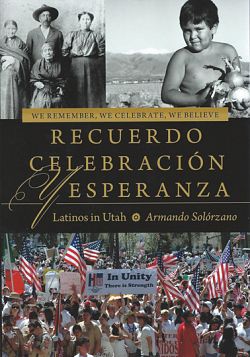New book by Cathedral's deacon explores 'Latinos in Utah' in words and photographs
Friday, Jan. 16, 2015

Intermountain Catholic
+ Enlarge
"We Remember, We Celebrate, We Believe. Recuerdo Celebracion Y Esperanza: Latinos in Utah," by Armando Solorzano. Salt Lake City: University of Utah Press, 2014.
From its beginnings as a photograph exhibit, the book We Remember, We Celebrate, We Believe. Recuerdo Celebración, y Esperanza: Latinos in Utah has been a dozen years in the making. Armando Solórzano, who holds joint faculty appointments at the University of Utah in ethnic studies and family and consumer studies, is director of Chicano Studies at the university, as well as being a permanent deacon at the Cathedral of the Madeleine. More than just a book of research – although its research is very impressive – this is the author’s own story, for he himself grew up in very humble circumstances as a member of a Mexican agricultural family.
The book’s scope is vast, ranging from the little-known 1765 expeditions of Juan Maria de Rivera, who journeyed north from Santa Fe all the way to the Colorado River at the present site of Moab, to the unfinished quest for comprehensive immigration legislation in our own day. As such, it is the first published attempt at a comprehensive history of Utah Latinos since Vicente Mayer’s ground-breaking essay in Helen Papanikolas’s 1976 Peoples of Utah.
Although the author duly notes the contributions of such well-known Latinos as anchorwoman Christina Flores, state senator Pete Suazo and Judge Andrew Valdez, the bulk of his text deals with the common people who comprise the bulk of our Latino population, and for whom conventional literary sources often do not exist. To fill that gap, the author exploited the approximately 100 oral history interviews conducted by staff members at the University’s American West Center, as well as some 50 interviews conducted by Leslie Kelen’s Center for Documentary Arts. He and his research associates also conducted many more interviews on their own.
As the author and his team worked among the Latino community, many people offered them photographs, which comprise a large part of the book’s significance and interest. From the photographs we get a vivid picture of the variety of everyday life, for we see people at work herding livestock, building a railroad, erecting a church, preparing lunch, relaxing in the living room, or playing music. Many of the photographs barely relate to the text of the book at all: They are individual portraits or family groups just staring into the camera. “We exist,” they seem to be saying, “we exist.” And so they do, all the while bolstering our economy, diversifying our society, and enriching our cultural life.
Publication of the book was made possible by generous subventions from a variety of sources, and it is a very handsome product as a result, including a section of color photographs, mostly by the author. Most remarkable, though, is the fact that, as the title hints, the book is bilingual: Each chapter in English is followed by the same text in Spanish. One could hope that it represents a new trend in publication of ethnic studies: Why write a book about a particular ethnic group, then publish it in a language that members of that group can read only imperfectly, if at all? Realistically, though, one suspects that the expense of such an endeavor will render this book a rare event.
This book has the potential to do a great deal of good for us Utah Catholics. Although precise figures on the number of Latino Catholics in Utah are unavailable, estimates run as high as 80 percent. If we are, then, a heavily Hispanic diocese, it is high time that the rest of us started getting to know those people in the next pew. Even more importantly, this fine book can go a long ways toward helping them get to know themselves.
We Remember, We Celebrate, We Believe. Recuerdo Celebracion Y Esperanza: Latinos in Utah, by Armando Solorzano. Salt Lake City: University of Utah Press, 2014. Paper, $19.95. Available at Magdalene Religious Goods & Coffee Grotto, 2030 South 900 East, Salt Lake City.
For questions, comments or to report inaccuracies on the website, please CLICK HERE.
© Copyright 2024 The Diocese of Salt Lake City. All rights reserved.
© Copyright 2024 The Diocese of Salt Lake City. All rights reserved.

Stay Connected With Us